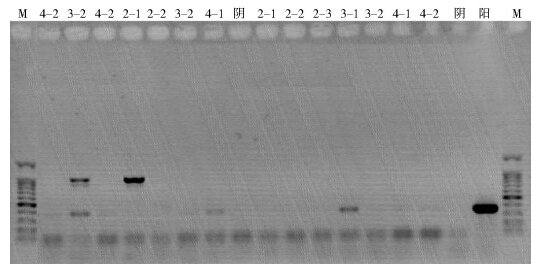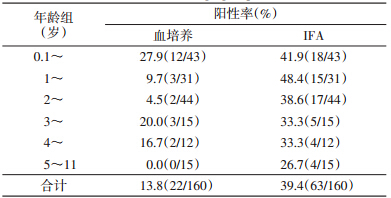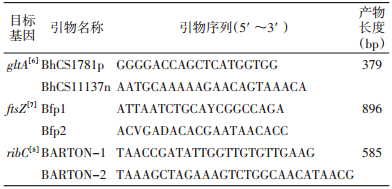
扩展功能
文章信息
- 黄儒婷, 宋秀平, 杨秀环, 栗冬梅, 赵帆, 孙继民, 刘起勇
- HUANG Ru-ting, SONG Xiu-ping, YANG Xiu-huan, LI Dong-mei, ZHAO Fan, SUN Ji-min, LIU Qi-yong
- 北京市宠物猫和流浪猫巴尔通体感染状况调查
- Investigation of infection with Bartonella in domestic and feral cats in Beijing, China
- 中国媒介生物学及控制杂志, 2015, 26(1): 19-22
- Chin J Vector Biol & Control, 2015, 26(1): 19-22
- 10.11853/j.issn.1003.4692.2015.01.005
-
文章历史
- 收稿日期:2014-09-30
- 网络出版时间:2014-12-17
2. 北京市丰台区疾病预防控制中心, 北京100071;
3. 北京市畜牧兽医总站
2. Fengtai Center for Disease Control and Prevention, Beijing 100071, China;
3. Beijing Veterinary Station
巴尔通体是一属新发现的能引起动物及人类不同疾病的微生物,包括22个种及3个亚种,属于变形菌纲、а亚纲、根瘤菌目、巴尔通体科、巴尔通体属,是一群革兰阴性,营养条件要求较高的细胞内寄生的需氧杆菌[1, 2]。17种巴尔通体可引起人卡瑞恩病(Carrin’s disease)、战壕热(Trench fever)、猫抓病(Cat scratch disease)、心内膜炎、菌血症和HIV(人体免疫缺损病毒)感染者的杆菌性血管瘤(bacillary angiomatosis)等疾病。巴尔通体分布广泛,动物宿主包括猫、犬及啮齿类,媒介昆虫包括白蛉、蚤、虱等。人类可能因为与携带巴尔通体的猫、犬等动物有较为亲密的接触、偶尔接触自然环境中的啮齿类野生动物或者被蚤、虱叮咬而感染巴尔通体[3]。随着居民与宠物猫的接触越来越密切及城市中流浪猫的增多,了解城市中猫的巴尔通体感染状况具有重要意义。 1 材料与方法 1.1 阳性对照菌株
巴尔通体标准菌株Bartonella henselae(ATCC49882)作为对照。 1.2 样品采集与保存
2009-2010年,在北京市城8区(东城、西城、宣武、崇文、朝阳、海淀、丰台、石景山区)采集猫静脉血样并收集相关的流行病学信息。血样分抗凝血与血清置于冻存管内,-80 ℃超低温冰柜保存。 1.3 巴尔通体分离培养
按文献方法[4],将抗凝血用灭菌胰酶大豆肉汤按1∶4稀释后,取100 μl接种于含5%去纤维羊血的脑心浸液培养基上,置于37 ℃、含5%CO2培养箱中分离培养至45 d。每日观察其生长情况并记录,对疑似菌落进行鉴定。 1.4 血清学检测方法
选择滴度1∶320为巴尔通体感染阳性标准,利用间接免疫荧光法(IFA)检测抗体水平。按照抗B. henselae抗体IgG检测试剂盒(欧盟医学实验诊断股份公司)说明书步骤进行检测。 1.5 遗传进化分析
挑取疑似菌落按文献方法[5]进行gltA、ftsZ、ribC PCR扩增并测序,反应引物见表 1。
将所测核酸序列进行同源性比较及系统发育分析,确定巴尔通体种。另选取22种巴尔通体菌株,利用核酸序列比对程序Blastn Programs进行核酸序列同源性搜索获得其相关序列。利用DNAStar 5进行猫分离株与选取菌株的序列同源性分析。利用Clustal W程序分别进行序列比对,所有序列末端对齐,按gltA-ftsZ-ribC顺序将1575 bp基因连接为多位点序列,用Mega 4软件中邻近法(neighbor-joining,NJ)基于核苷酸Kimura 2-parameter模型构建系统发育树,选择与巴尔通体近缘的布鲁氏菌(Brucella abortus)作为外群。 1.6 统计学处理
利用SPSS 13.0软件,采用率或构成比之间的χ2检验,分析实验室结果与现场采集的流行病学信息之间的关系。P<0.05为差异有统计学意义。 2 结 果 2.1 采样情况
在北京市城8区各采集20只猫血样,共采集160只猫血样。包括104只宠物猫,56只流浪猫,其中79只雄性,81只雌性。宠物猫平均年龄为2.7岁(2月龄至11岁)。 2.2 巴尔通体分离培养与遗传进化分析结果
共获得22株巴尔通体菌株,血培养阳性率为13.8%。菌落形态相似,灰白色、大小均一、较小的菌落,平均出现时间为8.8 d(5~19 d)。PCR测序结果用Blast与GenBank中注册的巴尔通体核酸序列进行同源性比较,显示与B. henselae最为接近(ribC 100%,gltA 100%,ftsZ 99%)。将测序结果提交GenBank,序列号分别为JQ009384-JQ009405 (gltA)、JQ009407-JQ009428 (ribC)和JQ316985-JQ317006 (ftsZ)。从系统发育树上可以看出,22株猫分离株与B. henselae亲缘关系最近,Bootsrap验证系统树的各分支有较高的支持率(图 1)。

|
| 图 1 基于多基因序列gltA-ftsZ-ribC(1575 bp)构建的22株猫分离株系统发育树 Figure 1 Phylogenetic dendrogram of 22 Bartonella isolates constructed by alignment of multiple gene sequences (gltA-ftsZ-ribC,1575 bp) |
样本血清抗B. henselae抗体IgG检测阳性率为39.4%。阳性样本在荧光显微镜下显示阳性对照类似的特异性荧光反应。 2.4 统计分析结果
抗凝血分离培养数据分析显示,流浪猫感染率明显高于宠物猫(χ2=20.036,P<0.01,表 2);染蚤猫的感染率明显高于未染蚤猫(χ2=24.239,P<0.01,表 3);幼猫(<7月龄)感染率明显高于性成熟猫(χ2=5.718,P=0.017),按年龄分组以1岁以内的小猫感染率最高(表 4)。血清IFA数据分析显示,染蚤猫抗体阳性率明显高于未染蚤猫(χ2=10.775,P=0.01)。不同地区猫感染情况差异无统计学意义,不同性别、不同品种、不同体重分组的猫感染情况差异亦无统计学意义。
 | ||
| 注:括号内数据为阳性数/样本数。 | ||
 | ||
| 注:括号内数据为阳性数/样本数。 | ||
 | ||
| 注:括号内数据为阳性数/样本数。 | ||
巴尔通体侵入人体出现菌血症,可引起几乎所有器官系统包括心脏、肝脏、脾脏、骨骼、骨髓、淋巴、肌肉、软组织及中枢神经系统等严重并发症[9]。汉赛巴尔通体引起的猫抓病是最常见的巴尔通体感染疾病。国内人群汉赛巴尔通体血清阳性率在9.6%~19.6%[10, 11]。1979-2007年,国内报道1631例猫抓病病例,发病年龄在2月龄至85岁之间,以青少年及成年人居多[12]。作为一种近些年才被发现和熟悉的病原体,巴尔通体感染引起的临床表现多种多样,无特异性,临床诊断困难,需借助实验室诊断才可确诊,临床感染病例误诊率及漏诊率均较高。另一方面,国内外均报道过自述无猫抓咬伤史的猫抓病病例[13, 14],提示即使没有可察觉的皮肤损伤,在与猫亲密接触的过程中也可导致巴尔通体侵入机体。因而,报道巴尔通体病例也许只是冰山一角。作为其最主要的宿主,猫在巴尔通体所致疾病的传播中意义重大。针对猫群的研究显示,猫普遍感染巴尔通体。如埃塞俄比亚报道11.0%的猫抗体阳性[15],阿尔及利亚检测猫群巴尔通体血培养感染率为17.0%[16]。国内最早于2005年在山东省的家猫中检测到汉赛巴尔通体[17],之后对一些地区进行猫感染情况的研究。如浙江省报道分离培养率为0[18],内蒙古、黑龙江、江苏、贵州等地分离培养率在3.57%~14.29%[19]。提示国内各地猫巴尔通体感染程度不同,北京、贵州等地猫感染率较高,浙江、内蒙古等地猫感染率较低,有可能是各地猫群蚤感染率不同所致。
本研究是首次在北京地区系统开展猫群巴尔通体感染情况的调查,从菌血症和抗体检测两方面证实北京城区的猫普遍存在巴尔通体感染。国内曾在家猫中检出汉赛巴尔通体和克氏巴尔通体[17, 20, 21]。遗传进化分析证实北京市猫体分离到的菌株均为汉赛巴尔通体,血培养感染率高,说明猫群菌血症携带率高,感染人类可导致较严重危害。流浪猫巴尔通体感染率较高,提示居民应减少与流浪猫接触或做好自身防护。蚤是猫之间传播病原体的媒介,本研究也显示染蚤猫的血培养阳性率和血清阳性率均高于未染蚤猫,提示灭蚤对家庭防止宠物猫感染巴尔通体的意义重大。有研究证实含10%吡虫啉和4.5%氟氯苯菊酯的颈圈可以有效预防猫群中蚤的传播[22],可用于防止家猫感染巴尔通体。国外有研究表明老猫血清阳性率较高,幼猫菌血症感染率较高[23],但在Yuan等[19]研究中,>8岁的老猫菌血症高。由于相关流行病学信息采集自猫饲养人,本研究仅获得宠物猫年龄。<1岁的幼猫菌血症携带率最高,3、4岁携带率也相对较高,但不同年龄组血清抗体水平差异无统计学意义,抗体未随年龄增长出现增高的原因还需进一步研究。北京市不同区域猫感染率差异无统计学意义,可能是由于各区域采样比例不均衡所致,不能分析不同区域的猫感染情况是否有差异。
本研究提示北京市猫巴尔通体感染率在国内属于较高水平,且均为对人致病的汉赛巴尔通体,需做好宠物猫的防蚤除蚤、流浪猫的管理来预防人类巴尔通体感染。
| [1] | Kaiser PO,Riess T,O'Rourke F,et al. Bartonella spp.: throwing light on uncommon human infections[J]. Int J Med Microbiol,2010,301(1):7-15. |
| [2] | Kerkhoff FT,Ossewaarde JM,de Loos WS,et al. Presumed ocular bartonellosis[J]. Br J Ophthalmol,1999,83(3):270-275. |
| [3] | 李小丽,阴赪宏. 对巴尔通体感染的临床认识[J]. 中国病原 生物学杂志,2012,7(11):872-875. |
| [4] | 宋秀平,刘起勇,鲁亮,等. 海南省小型兽类巴尔通体的分离 培养和序列分析[J]. 中国媒介生物学及控制杂志,2010,21 (2):131-133. |
| [5] | 栗冬梅,刘起勇,宋秀平,等. 中国家猫克氏巴尔通体分离株 生物学及分子特征分析[J].微生物学报,2009,49(4):429-437. |
| [6] | Norman AF,Regnery R,Jameson P,et al. Differentiation of Bartonella-like isolates at the species level by PCR-restriction fragment length polymorphism in the citrate synthase gene[J]. J Clin Microbiol,1995,33(7):1797-1803. |
| [7] | Zeaiter Z, Liang DX, Raoult D. Genetic classification and differentiation of Bartonella species based on comparison of partial ftsZ gene sequences[J]. J Clin Microbiol,2002,40(10): 3641-3647. |
| [8] | Johnson G,Ayers M,McClure SC, et al. Detection and identification of Bartonella species pathogenic for humans by PCR amplification targeting the riboflavin synthase gene(ribC)[J]. J Clin Microbiol,2003,41(3):1069-1072. |
| [9] | Breitschwerdt EB, Maggi RG, Nicholson WL, et al. Bartonella sp. bacteremia in patients with neurological and neurocognitive dysfunction[J]. J Clin Microbiol,2008,46(9):2856-2861. |
| [10] | Sun JM,Fu GM,Lin JF,et al. Seroprevalence of Bartonella in Eastern China and analysis of risk factors[J]. BMC Infect Dis, 2010,10(1):121-125. |
| [11] | Zhang LS,Shan A,Mathew B,et al. Rickettsial seroepidemiology among farm workers,Tianjin,People's Republic of China[J]. Emerg Infect Dis,2008,14(6):938-940. |
| [12] | 栗冬梅,张建中,刘起勇. 中国巴尔通体与相关疾病的研究进 展[J]. 中国人兽共患病学报,2008,24(8):762-765. |
| [13] | 王瑢,李婷薇,李知娟,等. 猫抓病1例报告及文献复习[J]. 广 东牙病防治,2013,21(5):267-269. |
| [14] | Koga T,Taguchi J,Suzuki M,et al. Cat scratch disease presenting with a retroperitoneal abscess in a patient without animal contacts[J]. J Infect Chemother,2009,15(6):414-416. |
| [15] | Tiao N,Darrington C,Molla B,et al. An investigation into the seroprevalence of Toxoplasma gondii,Bartonella spp.,feline immunodeficiency virus (FIV),and feline leukaemia virus (FeLV)in cats in Addis Ababa Ethiopia[J]. Epidemiol Infect, 2012,141(5):1029-1033. |
| [16] | Azzag N,Haddad N,Durand B,et al. Population structure of Bartonella henselae in Algerian urban stray cats[J]. PLoS One, 2012,7(8):e43621. doi: 10.1371/journal.pone.0043621. |
| [17] | 栗冬梅,孟凤霞,秦增军,等. 山东省家猫检出汉赛巴尔通体[J]. 中国媒介生物学及控制杂志,2005,16(6):452. |
| [18] | 傅桂明,孙继民,刘起勇,等. 浙江省家猫中汉赛巴尔通体感 染的流行病学调查[J]. 中国媒介生物学及控制杂志,2008, 19(2):138-140. |
| [19] | Yuan CL,Zhu CX,Wu YB,et al. Bacteriological and molecular identification of Bartonella species in cats from different regions of China[J]. PLoS Negl Trop Dis,2011,5(9):e1301. doi: 10.1371/journal.pntd.0001301. |
| [20] | 杨小冉,刘起勇,崔步云,等. 河南山东部分地区家猫汉赛巴 尔通体感染情况调查[J]. 疾病监测,2007,22(8):544-546. |
| [21] | Liu QY,Eremeeva ME,Li DM,et al. Bartonella and Bartonella infections in China:from the clinic to the laboratory[J]. Comp Immunol Microbiol Infect Dis,2012,35(2):93-102. |
| [22] | Lappin MR,Davis WL,Hawle JR,et al. A flea and tick collar containing 10% imidacloprid and 4.5% flumethrin prevents flea transmission of Bartonella henselae in cats[J]. Parasit Vectors, 2013,6:26. |
| [23] | Chomel BB,Abbott RC,Kasten RW,et al. Bartonella henselae prevalence in domestic cats in California: risk factors and association between bacteremia and antibody titers[J]. J Clin Microbiol,1995,33(9):2445-2450. |
 2015, Vol. 26
2015, Vol. 26





